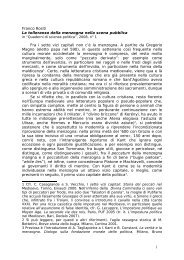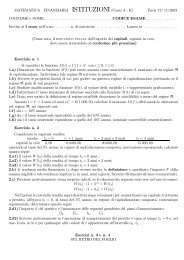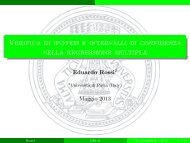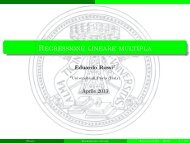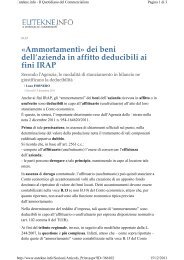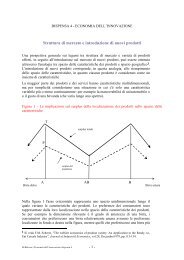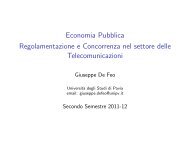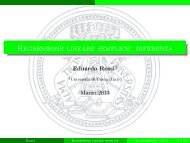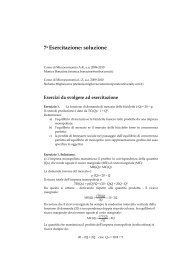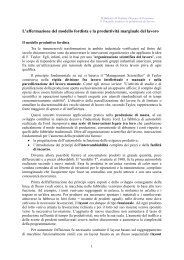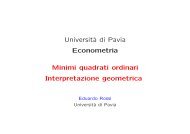International Incoming Student's Guide - Università degli studi di Pavia
International Incoming Student's Guide - Università degli studi di Pavia
International Incoming Student's Guide - Università degli studi di Pavia
You also want an ePaper? Increase the reach of your titles
YUMPU automatically turns print PDFs into web optimized ePapers that Google loves.
<strong>International</strong> <strong>Incoming</strong> Student’s <strong>Guide</strong><br />
10. Tourism and free time<br />
10.1 History<br />
The city of <strong>Pavia</strong> was founded on the left bank of the River Ticino more than two<br />
thousand years ago. Nowadays, almost 75.000 people live in this city situated only 35 km<br />
from Milan. <strong>Pavia</strong> was founded in the 5th century B.C. as a Gaul‐Ligurian village; it<br />
became a Roman colony in 89 B.C. and was called Ticinum. The city was organized in<br />
accordance with the typical structure of a Roman castrum with streets meeting at 90‐<br />
degree angles ‐ still to be appreciated in the structure of the modern city. Thanks to its<br />
favourable strategic position, controlling the area crossed by the Rivers Ticino and Po,<br />
<strong>Pavia</strong> played a major political and economic role during the late Roman Empire and the<br />
early Middle Ages. It came to be known as Papia and retained its strength and prestige as<br />
a capital city under the Ostrogoths and, subsequently, under the Lombards (572) and<br />
Franks (774). For centuries <strong>Pavia</strong> was an important centre of the future Sacred Roman<br />
Empire: King Lotharius, in 825, established an important imperial school of law and<br />
several monarchs and emperors were crowned in <strong>Pavia</strong>. The city was also one of the most<br />
important stages along the antique Via Francigena, the pilgrim’s route lea<strong>di</strong>ng from<br />
Canterbury to St. Peter’s tomb in Rome. Having become an independent municipality<br />
thanks to its economic prosperity, <strong>Pavia</strong> was able to lay the foundations for a lively urban<br />
development and the flourishing of Romanesque art. However, during the Middle Age,<br />
the town lost its prosperity and political relevance, until it passed under the Seigniory of<br />
the Visconti family, when <strong>Pavia</strong> became one of the most elegant courts of the Italian<br />
Renaissance. In 1360, the Visconti family established the university, which is one of the<br />
oldest in Italy and Europe. The Sforza seigniory, after the Visconti rule, began the<br />
construction of major public buil<strong>di</strong>ngs such as the first core of the university and the<br />
cathedral. In 1872 the city was partly mo<strong>di</strong>fied, starting from the demolition of the<br />
me<strong>di</strong>eval walls.<br />
10.2 Weather<br />
The weather in <strong>Pavia</strong> is typical of the lower Pianura Padana, rainy and humid. Fall is foggy,<br />
winter is cold (sometimes it snows), spring is warm but it often rains and summer is hot,<br />
with sudden storms. The best period is between spring and summer. There are lots of<br />
mosquitoes during the summer! Insect repellents are definitely worth a try.<br />
10.3 Sightseeing and Museums<br />
10.3.1 Sightseeing<br />
<strong>Pavia</strong> is a small town but it offers a number of touristic and cultural attractions, like the<br />
Castello Visconteo (1360). The castle was built as an armed stronghold and a lordly<br />
residence. It has an imposing quadrangular structure and a very nice courtyard,<br />
characterized by the elegance of its architectural components and the airy porticoes and<br />
loggias. Another charming castle near <strong>Pavia</strong> is the Castello <strong>di</strong> Mirabello (XIV century).<br />
Piazza Vittoria (XIV century), the most beautiful square of <strong>Pavia</strong>, is the very heart of the<br />
town. It is dominated by the elegant buil<strong>di</strong>ng Broletto (XII century) and the imposing and<br />
University of <strong>Pavia</strong> – <strong>International</strong> Relations Division<br />
Corso Strada Nuova n. 65, 27100 <strong>Pavia</strong><br />
welcomepoint@unipv.it Tel +39 0382 984021 Fax +39 0382 984695<br />
47



